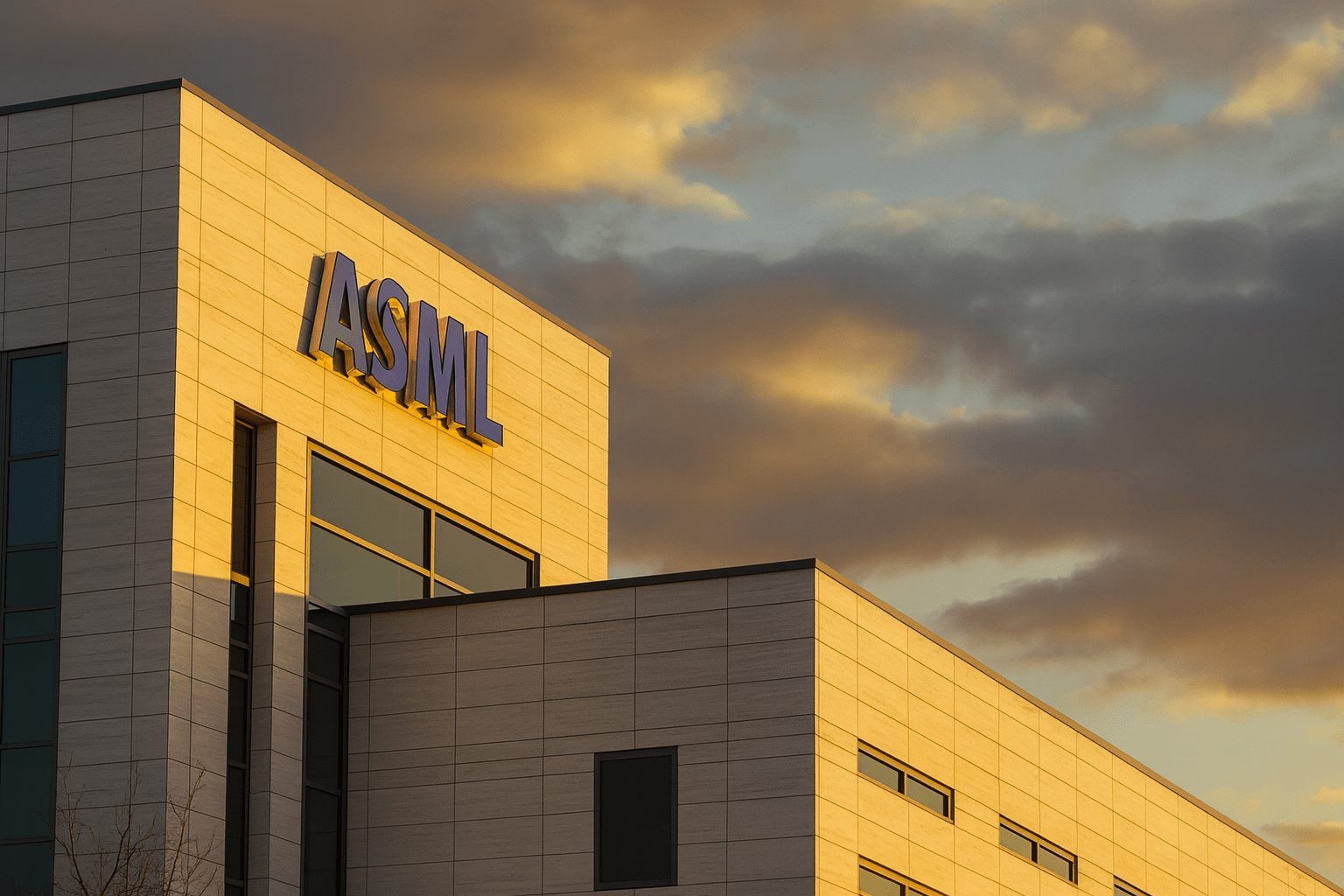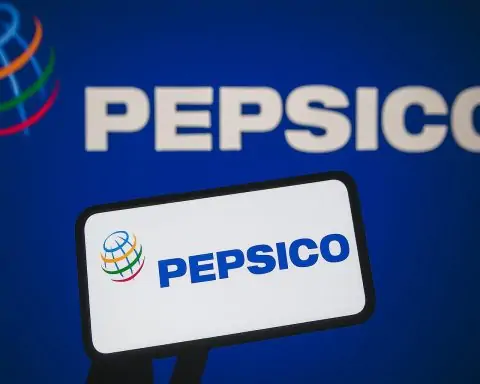ASML Holding NV (NASDAQ: ASML) heads into the new trading week near record territory, as investors weigh explosive AI-driven demand for its chipmaking tools against rising geopolitical and valuation risks.
As of the latest U.S. close before the weekend, ASML’s U.S.-listed shares finished around $966.57, down roughly 1.5% on the day but still up more than 40% year to date in 2025, reflecting how aggressively markets have re-rated the company during the AI infrastructure build‑out. [1]
ASML stock price snapshot: volatility at high levels
In the most recent session, ASML traded between an intraday low near $946 and a high just above $988, with volume around 2.5 million shares, underscoring brisk activity for a mega‑cap European tech name that trades heavily on both Nasdaq and Euronext.
At a share price just under $1,000, ASML is effectively priced as a core “picks and shovels” supplier for the AI era. That lofty tag makes the stock particularly sensitive to any changes in:
- AI data‑center capital‑expenditure plans
- Order momentum for EUV and High‑NA EUV tools
- Headlines around export controls and China
With markets closed on Sunday, Nov. 23, 2025, investors are using the pause to digest a dense stream of Q3 numbers, guidance, and fresh analyst calls.
Q3 2025: strong earnings, stronger guidance
ASML’s latest quarterly report, released on Oct. 15, 2025, is the backdrop for today’s price action. The company delivered: [2]
- Q3 2025 net sales: about €7.5 billion
- Gross margin: ~51.6%
- Net income: roughly €2.1 billion
- Net bookings: about €5.4 billion, including €3.6 billion of EUV orders
Management guided for Q4 2025 sales between €9.2 billion and €9.8 billion with gross margins in the low‑50s, and reiterated expectations for around 15% total net sales growth in 2025 with full‑year gross margin near 52%. The company also emphasized that 2026 revenue should not fall below 2025 levels, a key reassurance given investor worries about a post‑AI “air pocket.” [3]
Earnings commentary and subsequent coverage highlighted a familiar pattern:
- Strong demand from AI‑related logic and advanced DRAM customers
- Bookings slightly ahead of consensus
- Cautious but not catastrophic messaging on 2026, especially around China
That combination has helped keep bullish long‑term narratives intact while leaving the stock exposed to short‑term swings whenever macro, AI spending or China headlines wobble.
AI and EUV: why ASML sits at the center of the chip boom
ASML remains the only company in the world capable of producing extreme ultraviolet (EUV) lithography systems at scale, tools required for the most advanced chips used in GPUs, CPUs and high‑bandwidth memory powering AI data centers. [4]
Several recent data points reinforce how central that positioning has become:
- A Reuters Q3 wrap noted that net bookings beat expectations as AI‑related investments broadened across both advanced logic and memory customers, including major foundries and memory makers. [5]
- S&P Global analysis projects 2025 EUV revenues to rebound sharply after a 2024 dip, with EUV (including High‑NA) sales expected to rise roughly 49% year over year and High‑NA EUV revenue seen tripling to around €1.7 billion. [6]
- ASML’s own Q3 commentary confirmed that it recognized revenue from its first High‑NA EUV system and continues to ramp the technology. [7]
High‑NA EUV is the next step in ASML’s roadmap. By increasing the numerical aperture of the optics, the new EXE‑class tools can print features roughly 1.7× smaller, enabling about 2.9× higher transistor density versus today’s mainstream EUV machines. [8]
In parallel, ASML is weaving AI into its own portfolio. The company recently highlighted a strategic partnership with Mistral AI to embed AI across its software and services stack, with the goal of improving tool productivity and customer yield. [9]
Put simply: as long as hyperscalers, chip designers and memory makers keep racing to build denser, more power‑efficient silicon for AI workloads, ASML’s EUV and High‑NA franchises sit near the center of that spend.
China, export controls and the 2026 overhang
For all the AI tailwinds, China remains the biggest strategic overhang on ASML stock.
In its Q3 update and subsequent media coverage, ASML said it expects China sales to “decline significantly” in 2026, after Chinese customers accounted for nearly half of sales in 2024 and roughly one‑third of tool sales so far in 2025. [10]
Key dynamics:
- U.S.-led export restrictions prevent ASML from shipping its most advanced EUV systems to China, and newer rules also constrict sales of some deep ultraviolet (DUV) tools. [11]
- Management stresses that the expected drop reflects a normalization after two boom years, not just last‑minute stockpiling. [12]
- Even with lower China exposure, ASML believes global AI and advanced-node demand will keep overall 2026 sales at or slightly above 2025’s roughly €32.5 billion level. [13]
Analysts are split on how to frame this:
- Some see 2026 as a “pause year” before the next up‑cycle in 2027–2028 as more EUV and High‑NA capacity comes on line. [14]
- Others worry that any further tightening of export controls or slowdown in AI capex could expose ASML’s premium valuation.
Either way, China is likely to remain a top‑of‑mind risk factor every time ASML updates its order book or long‑term model.
Building capacity in the U.S.: the Phoenix technical academy
While geopolitics add uncertainty, ASML is quietly investing to secure its operational moat.
On Nov. 20, 2025, the company opened a new U.S. technical training academy in Phoenix, Arizona, just minutes from the city’s airport. The facility is designed initially to train more than 1,000 engineers per year to service ASML’s complex DUV and EUV systems, with capacity eventually rising to around 2,000 people annually. [15]
Highlights from the Reuters report and ASML comments: [16]
- The academy supports the major chip‑fab build‑outs by Intel and TSMC in the Phoenix region, as well as expansions by Samsung in Texas and Micron elsewhere in the U.S.
- ASML is targeting ex‑military personnel—such as former Navy and Air Force technicians—as ideal recruits due to their experience maintaining advanced hardware.
- Initial training for basic maintenance takes three to six months, while more advanced repair training is longer.
- High‑NA EUV training will still take place in the Netherlands for now, as those tools remain in the qualification phase with customers.
From an investment standpoint, this move signals ASML’s long‑term commitment to the U.S. manufacturing ecosystem created by the CHIPS Act and related incentives. More trained engineers should, over time, help improve service response times, tool uptime and customer satisfaction—key levers in ASML’s growing installed‑base and services revenue.
Institutional flows and the valuation debate
At today’s price levels, a central question for investors is whether ASML stock still offers attractive upside—or whether much of the AI story is already priced in.
Recent filings suggest that institutional appetite remains strong, even among smaller and mid‑sized players:
- AlphaCore Capital LLC recently disclosed that it boosted its ASML position by about 64%, to roughly 2,275 shares valued near $1.8 million, according to a new 13F filing. [17]
- Enterprise Financial Services Corp reported a new position in ASML, further illustrating how widely the stock has penetrated institutional portfolios beyond global mega‑funds. [18]
On the valuation side, different frameworks yield different answers:
- A Simply Wall St analysis points to an outlook of around €39.6 billion in revenue and €12.1 billion in earnings by 2028, implying about 7% annual revenue growth and a material uplift from today’s earnings base. Their discounted cash‑flow model suggests a fair value near €941.90, only about 6% above the current Amsterdam price, with community estimates ranging from roughly €573 to €1,000 per share. [19]
- Morningstar recently bumped its fair value estimate to approximately €850 (about $980), citing “healthy EUV momentum, service growth and logic exposure,” and now views the shares as roughly fairly valued rather than deeply undervalued. [20]
- A Goldman Sachs note highlighted by Benzinga went further on the long‑term upside, arguing that ASML’s revenue could more than double relative to its own 2030 expectations in a bullish scenario that assumes around 104 EUV tools shipped that year, driven by AI‑driven EUV demand. [21]
Taken together, these views suggest:
- Near‑term valuation is rich but not obviously extreme if ASML hits its 2028–2030 targets.
- The stock’s upside is increasingly tied to how big the AI infrastructure build‑out ultimately becomes, and how much of that demand translates into EUV and High‑NA orders.
- Any disappointment in bookings, AI data‑center capex, or 2026 guidance could trigger sharp pullbacks from current levels.
High‑NA EUV: breakthrough or over‑hyped?
One nuance often missed in the headlines: while High‑NA EUV is technologically impressive, adoption is not guaranteed to be smooth or universal.
Industry reporting suggests: [22]
- High‑NA EUV tools can cost $360–400 million per machine, making them some of the most expensive pieces of manufacturing equipment ever built.
- Some chipmakers, such as TSMC, are reportedly taking a cautious approach—planning to skip High‑NA on certain near‑term nodes and instead squeezing more out of existing EUV with multiple patterning.
- Intel, an early adopter, has faced sustained financial pressure in its foundry business, highlighting the execution and return‑on‑investment risks for chipmakers betting heavily on the new platform.
For ASML, this creates a dual reality:
- If High‑NA adoption accelerates across leading foundries and memory makers in the late 2020s, it could extend ASML’s growth runway well into the next decade.
- If customers decide that costs outweigh benefits on certain nodes, High‑NA could become a slower, more lumpy contributor, and growth would rely more on standard EUV, DUV and services.
Key factors to watch for ASML stock this week and beyond
As investors look past the Q3 print and into 2026–2030, several catalysts are likely to drive ASML’s share price:
- Order and booking updates
- Any commentary on EUV and High‑NA bookings versus expectations will be scrutinized.
- Watch for signs that AI‑driven demand is broadening beyond a handful of hyperscalers and memory vendors.
- China and export‑control developments
- New U.S. or Dutch restrictions on tool exports—or, conversely, signs of stabilization—could quickly reprice the stock’s risk premium. [23]
- 2026 guidance and the next investor update
- ASML has flagged that it will share more detail on its 2026 outlook in January 2026, including how it plans to offset a drop in China sales. [24]
- High‑NA EUV customer milestones
- Watch for announcements that customers have moved from qualification into high‑volume manufacturing on High‑NA nodes, which would validate the business case and support long‑term forecasts. [25]
- Capital‑return plans
- ASML has indicated it does not expect to complete its current €12 billion buyback program in full by the end of 2025, and plans to announce a new share‑repurchase program in January 2026. Details on that plan could influence investor sentiment around capital allocation. [26]
Bottom line: ASML stock on Nov. 23, 2025
Heading into the final stretch of 2025, ASML stock is:
- Pricing in strong AI‑driven growth, especially in EUV and services
- Navigating material China and policy risk, as export controls reshape its geographic mix
- Trading at valuations that assume the company largely delivers on its 2028–2030 roadmap
For long‑term watchers, the core thesis hasn’t changed: if AI‑related chip demand remains robust and EUV/High‑NA adoption plays out as expected, ASML could justify its premium and potentially grow into even higher revenue and earnings levels over the next decade. But at today’s share price, execution missteps, policy surprises or a cyclical pause in AI capex could produce significant volatility along the way.
This article is for informational purposes only and is not investment advice. Always do your own research and consider speaking with a licensed financial adviser before making investment decisions.
References
1. www.investopedia.com, 2. www.asml.com, 3. www.asml.com, 4. www.benzinga.com, 5. www.reuters.com, 6. www.spglobal.com, 7. www.investing.com, 8. www.asml.com, 9. www.asml.com, 10. www.reuters.com, 11. www.reuters.com, 12. www.reuters.com, 13. www.reuters.com, 14. www.reuters.com, 15. www.reuters.com, 16. www.reuters.com, 17. www.marketbeat.com, 18. www.marketbeat.com, 19. simplywall.st, 20. global.morningstar.com, 21. www.benzinga.com, 22. semiwiki.com, 23. www.reuters.com, 24. www.asml.com, 25. www.spglobal.com, 26. www.asml.com







